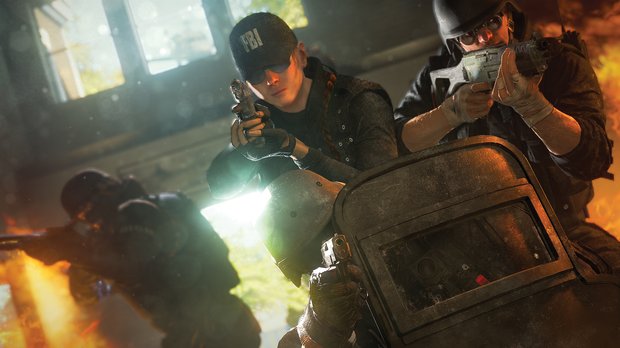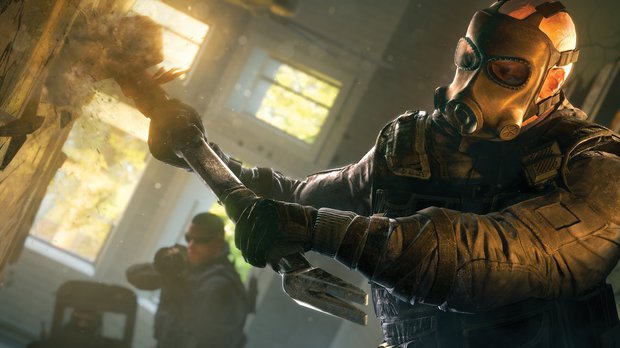Rainbow Six Siege - one of the most tense tactical shooters you'll ever play
We love a good team deathmatch here at GamesRadar+. But let’s face facts; unless you’re part of a super-organised clan, it can be difficult to see the bigger picture when you’re in the middle of a skirmish. Not so with Rainbow Six Siege. A methodical, tactical shooter, Siege makes sure each and every member of the team is held to account – from the moment they choose their loadout, to long after they kick the proverbial bucket.
Siege’s cornerstone multiplayer mode, also called Siege (are you still following me?) was first revealed to the world at E3 2014, and the general premise of it hasn’t changed much between then and my new hands-on session with the game. It’s an asymmetrical affair where groups of five wage war over a hostage in a succession of cramped, interior maps. One side is tasked with extracting the hostage, the other with keeping the invaders at bay until the timer runs out. Either team can also win the round by eliminating the opposition, or by tricking them into shooting dead that poor hostage.
Since your health doesn’t regenerate, and there’s no respawning, rounds tend to be short, lethal and broadly separated into three phases. First, there’s the preparation stage - a one-minute warning where the defending squad chooses where to locate the hostage, and then go about fortifying the position, deciding which entry points to barricade and which to leave open so the defenders have space to retreat if things go south. Meanwhile, the opposing team are on a scouting mission - armed with a set of tiny drones capable of rolling under doorways.
These drones’ primary objective is to locate the hostage, but it’s also important to park them in a strategically valuable location when the ‘Ready Phase’ ends, as they turn into tiny portable cameras that deceased players can flick between and use to advise active players. See what we mean? You can be held accountable for your team’s success even long after you’ve bitten the bullet.

After the minute’s up, the chains are cut and the attacking team is free to lay siege to the building. This part of the action is typically the longest, and is fraught with tension and paranoia as both sides gingerly poke around the environment, attempting to sound out where the other outfit is located. For the defending group, this is a particularly worrying time; you might be able to cover all the natural entrances, but all wooden structures within levels are fully destructible. This means the opposing squad can create new entrance points by placing breach charges on solid walls, blocked-off doors or even the floor.
The level of destruction that can be wrought in each stage is impressive, even by PS4’s lofty standards, and it means that no two rounds ever play out the same. As my playtest session wears on, I see some defenders pre-empt the destruction by opening fire and re-shaping the cramped environments before the attackers can even enter the interior, giving them what you might call a homefield advantage when the round begins proper. Of course, these kinds of things need to be communicated properly with your teammates.

Fortunately, there’s a load-out for every eventuality - but even this choice involves responsibility. The newly revealed ‘Operator’ system offers 20 soldiers to choose from (10 on each side) - however, you can only have one of each type of operator in your team, with the exception of the ‘Recruit’, who doesn’t have a special ability to offer. On the defending side, for example, ‘Castle’ is capable of building hardened reinforcements that can’t be breached - so this player needs to quarterback the fortification process over the mic. ‘Pulse’ on the other hand is unlikely to ever fire a gun in anger - their primary ability is an iPad-like device that allows the player to see the other team’s hearts through solid walls. A team that has, and listens to, a competent Pulse player will have the jump on the opposition, taking aggressors by surprise by shooting at them through solid walls.
Sign up to the GamesRadar+ Newsletter
Weekly digests, tales from the communities you love, and more
Duty. Responsibility. Accountability. From your load-out to your choice of spawn point, to the walls you destroy to what you say over the mic, these words ghost your every move. When the round is over, you know exactly why you won or lost - and who was to blame. It’s a strategically rich shooter that delivers on its promise of harking back to the more cerebral days of Counter-Strike, and our only hope now is that all online players approach this compelling setup in the spirit the studio intends.
We are Play magazine, the biggest-selling,100% independent, magazine for PlayStation gamers. Founded in 2021, it's brought to you by the same team of writers, editors, and designers as the Official PlayStation Magazine, with the same deep industry access, quality of writing, and passion for all things PlayStation. Follow us for all things PS5, PS4, and PlayStation VR.



